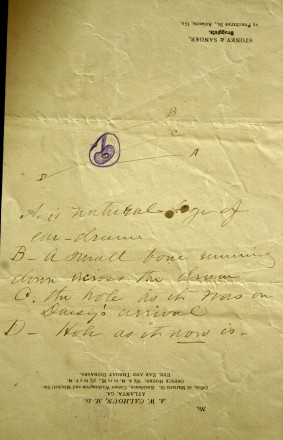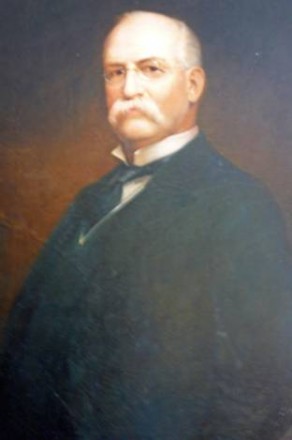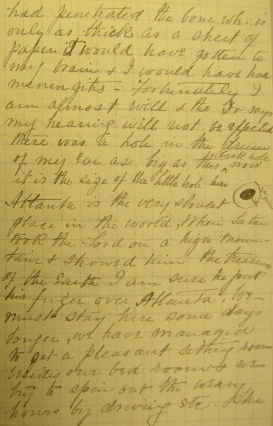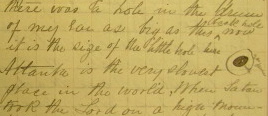I know I am not the only one who gets goosebumps from amazing documents connected to the life of Juliette “Daisy” Gordon Low. So, for those of you who, like me, love “history in the raw,” here’s something I bet you’ve never seen: a drawing of what was wrong with Daisy’s ear, done by her physician:
Cool, huh?! But as a historian, I don’t know nearly enough about this document. The date, for one thing, is missing, although I can guess. Nor do I know precisely why it’s in the family papers, but I can concoct a scenario. It is a grand and glorious thing to be dependent upon the documents as historians are, especially when the documents are this awesome. But it is troublesome when there are gaps. Because of that, I did not cite this document in my book. If I knew all I needed to, and if I could have illustrated Juliette Gordon Low: The Remarkable Founder of the Girl Scouts with even more photos, I would have included this, and I would have put it right around page 94. I think this document was from early 1885, and fits in with the story about the silver nitrate that opens Chapter Six.
Here’s my best educated guess as to the background on this document:
The terrible ear ache of 19 January 1885, struck. After local physician James Houston treated Daisy with silver nitrate, her ear did not improve. She told a friend that it was Dr. Houston’s fault because he had “burned a hole through the [ear]drum.” Her ear continued to bleed and to hurt, and so Dr. Houston, with the assistance of Dr. James B. Read, suggested that Daisy see a specialist in Atlanta, the well-known ear, nose, and throat doctor, Abner Wellborn Calhoun.
Dr. Calhoun, a Confederate veteran, was a respected medical lecturer and writer, trained in Philadelphia and Europe. At the time he met Daisy, he was also the president of the Medical Association of Georgia. He taught at the College of Physicians and Surgeons in Atlanta, and his star was rising. In his future was the presidency of the College and the vice-presidency of the American Medical Association. It was natural that Dr. Houston would send Daisy Gordon to Dr. Calhoun.
In late January, Daisy’s father, Willie Gordon, ferried her to Atlanta as her mother, Nellie Gordon, was in New Jersey welcoming the first Gordon grandchild into the world. What happened when Daisy became Dr. Calhoun’s patient? He sedated and treated her, and then tried to explain to the anxious father what was wrong. This is where I think the document comes in. I imagine:
Dr. Calhoun sitting across his big mahogany desk from Willie Gordon. Dispensing with the jargon, Dr. Calhoun reaches for a sheet of stationary and leans in to draw the worried father a picture of what he seems incapable of actually hearing–even though the news is positive. Focusing on Willie, Calhoun ignores the fact that his paper is upside down. Here, he says, grasping the nearby pencil and sketching a rough circle, “is the natural size of [Daisy’s] ear drum.” And here is “a small bone running down across the drum.” This (he shades in a shape like a large lima bean) is “the hole as it was on Daisy’s arrival.” And this (he cordons off a much smaller circle inside the lima bean) is the “hole as it now is.” Then Dr. Calhoun pushes the drawing toward Willie.
Slowly, the realization dawns upon Willie that his daughter is improving. He sighs as one brought back from the gallows. “Doctor,” he says slowly, “would you please label this for my wife, so that when she arrives I can explain it to her as you did to me?” The courtly Dr. Calhoun reaches into his coat, removes and uncaps his pen, dips it into the inkwell, and methodically adds a written description, complete with steps “A” through “D.” Willie stands, shakes the physician’s hand gratefully, and hurries off to cheer up his daughter with the evidence of her recovery.
The supporting evidence for my interpretation is in a letter that Daisy wrote to a friend, in which she herself drew a picture somewhat similar to Dr. Calhoun’s.
What does this tell us? That the great Dr. Abner W. Calhoun did indeed treat Daisy Gordon, and that he saw improvement from the original hole made by the silver nitrate–if I am correct about the date. I think I am. It fills in more details about the perplexing hearing loss that shaped so much of Daisy’s life. And it provides one of those “matters of less moment” that help us construct the best biographies.
If we wanted to push the interpretation a bit further, we could compare the drawings. Calhoun’s hole is considerably smaller than Daisy’s. Does that mean that Daisy exaggerated? That Calhoun, the professional, had a better understanding of the exact size of an actual eardrum? Or that Daisy’s pain just felt that big? Hmmmmm…..
_________
For more on Dr. Calhoun, see his obituary in the Atlanta Constitution, 22 August 1910, page 3. See also the Atlanta Journal-Record of Medicine, July 1900, p. 235, for his being vice president of the AMA; Calhoun’s “Polyps in the External Auditory Canal,” the Atlanta Journal-Record of Medicine, May 1885, pp. 137-139; outgoing president of the Medical Association of Georgia, from the Atlanta Medical and Surgical Journal, May 1885, p. 146; Calhoun’s “Irido-Choroiditis Following Meningitis,” the Atlanta Medical and Surgial Journal, June 1885, pp. 233-234; Calhoun’s “Glaucoma,” the Atlanta Medical and Surgical Journal, August 1885, p. 348; for his being president of the College of Physicians and Surgeons in Atlanta, see http://files.usgwarchives.net/ga/taylor/history/physicians.txt; for his expertise in cataract operations, see the Atlanta Medical and Surgical Journal, February 1885, 699. The photo of Dr. Calhoun is from http://www.electricscotland.com.
The drawing from Dr. Calhoun comes from the Gordon Family Papers, 1810-1968, MS2235, Southern Historical Collection, Wilson Special Collections Library, University of North Carolina at Chapel Hill.
The letter from Daisy is Juliette Gordon Low to Mary Carter Clarke, 8 February 1885, MS2800/6/15, George Hyde Clarke Family Papers, Division of Rare and Manuscript Collections, Cornell University Library.
_____






thank you sooo much for these. I recommend your bio of Juliette wherever I travel with my sculpture for those who want to know more about this amazing woman.
Paige–Merana–You are both so welcome! Thanks for taking the time to write in, and thanks for reading my blog–I am honored!
This is wonderful! I love your interpretation. Thank you for sharing this, Stacy!
FAB!
Stacy, This is so interesting! You must tell staff about it when you are here on Thursday! Looking forward to seeing you.
This is extremely interesting to me as I suffered many ear infections and ended up with a pierced ear drum like Daisy’s.
Fortunately (this is back in the 1960s) I was sent to a superb doctor at UCLA who actually made a skin graph onto my ear drum so that my hearing was saved. The graph didn’t work the first time and it had to be done a second time. This was a fairly new procedure at the time and probably saved my hearing. I do have a slight loss, but even at my advancing age the hearing remains pretty good. No skin graph on the drum would have meant a severe loss of hearing. Just another perspective…!
Thanks, Christie–
Thanks for sharing this! Our Daisy Scout is deaf and we’ve been searching with her for more information on Juliette Low’s hearing loss.
Hi, Monica–I urge you to buy my biography of Daisy Low–it’s the first one written in over half a century, and it’s got all kinds of new information on Juliette Low’s deafness. It’s coming out in paperback in seven days–on the 29th of January. Here’s a link to the amazon page, but you can get it at your Girl Scout Council shop or any independent bookstore near you, too. http://www.amazon.com/Juliette-Gordon-Low-Remarkable-Founder/dp/0670023302
Thanks,
Stacy
Thanks for a fascinating bio of Daisy!
You mention Harriet Martineau visiting the Gordon family when Daisy was young, any mention of them noticing Harriet’s hearing loss? Also wonder who the other “hearing impaired friends” were who attended the musical at the end of the book. The impression has been that Daisy didn’t seem to associate much with other Deaf people.
Thanks !
Hi, Kc–
No–no one remarked upon Martineau’s hearing.
And you are right that Daisy did not associate purposefully with deaf people, but she herself was not profoundly deaf.
Thanks for your kind words about my biography of Juliette Low–I’m so glad you enjoyed it!
Stacy
I have empathy for those who suffer from ear problems. I lost the hearing in my left ear from an infection that was not properly treated. I needed antibiotics but received ear drops and heat lamp. This led to further damage requiring radical surgery which did save my life. I do have a document with Juliette Low’s, and all the world Girl Guides from a gathering in the 1920’s in England. There do not seem to be very many autographs by her, but a search led me to the drawing of her ear and her dealing with hearing issues. Thank you for sharing.
Thank you! I thoroughly enjoyed writing her biography, and I’m glad you enjoyed the blog.